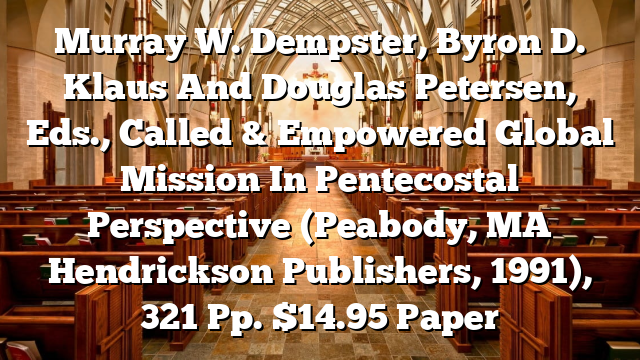Click to join the conversation with over 500,000 Pentecostal believers and scholars
Click to get our FREE MOBILE APP and stay connected
| PentecostalTheology.com



113 Murray W. Dempster, Byron D. Klaus and Douglas Petersen, eds., Called & Empowered: Global Mission in Pentecostal Perspective (Peabody, MA: Hendrickson Publishers, 1991), 321 pp. $14.95 paper. Reviewed by L. Grant McClung, Jr. Who has the answer to what Pentecostals believe about mission and the description of how they go about doing mission? Coming out of a sense of urgency that caused them to “act now and theologize later,” Pentecostals have been known more for action than reflection. Identifying who the Pentecostals were and how they did the job was a task largely left up to sympathizers from groups such as the Church Growth Movement. Other outside observers, however, were not always so sympathetic. This book is a statement by Pentecostals about Pentecostal missions, a move toward what I have called a “Decade of Self-Definition in the 1990s.” What has emerged since the mid 1980s are signs of a budding “pentecostal missiology,” a development exemplified in this volume. Readers of this excellent new contribution will find that Pentecostals have a broader understanding of wholistic mission issues than the supposed limited agenda of evangelism/church planting via the supernatural. This collection of twelve articles–all from Assemblies of God authors–and three “outside observer” responses has something to say about biblical/theological dimensions, the integration of gospel and culture, response to non-Christian religions, and missiological strategy. It reads well as a text (which I am using) or as a pre-study tool, for example, for a field conference or consultation devoted to understanding the Pentecostal/Charismatic contribution to world evangelization. The three editors are professors at Southern California College in Costa Mesa, California, a Christian liberal arts college sponsored by the Assemblies of God, and are also involved in Latin America ChildCare, an Assemblies of God ministry to underprivileged children in sixteen Latin American countries. The editors introduce each of the five sections of the book with a rationale for the theme of the section and a brief synopsis of each chapter in the section. These sectional introductions give an overall conceptual coherence to the volume, reducing the choppiness and unevenness that often attend multi-authored anthologies. Gordon Fee opens the first section on “Biblical and Theological Dimensions of Global Mission in the Pentecostal Tradition” with a chapter which aims to demonstrate that the roots of the Pentecostal conviction about the global mission of the church are to be found in Jesus’ proclamation of the kingdom of God. In the next chapter, 1 114 Murray Dempster utilizes the concept of the kingdom of God as an integrating center in the development of a wholistic Pentecostal theology which features evangelism, social service and social action. Douglas Petersen in the third chapter of this section adopts and modifies “the hermeneutical circle” of Latin American liberation theologians in order to promote a Pentecostal praxis which applies Jesus’ message of the kingdom within the context of the Third World. Section two focuses on “The Emerging Pentecostal Integration of Gospel and Culture” and features chapters written by Everett Wilson, Augustus Cerillo, Jr., and Del Tarr. Wilson analyzes the phenomenal growth of Pentecostalism in Latin America from a functional perspective, identifying the changing social conditions in Latin culture which encouraged indigenous, national Pentecostal leaders to create “a church of the people.” Cerillo identifies the issues that Pentecostals face in light of the ever-increasing global trend of urbanization, and offers some pertinent suggestions for formulating effective urban ministries. In rounding out this section, Tarr develops a model of communication for preaching the gospel across the different cultural regions of the globe. The issue of gospel and culture is taken up again in section three but the issue is analyzed from the perspective of differing worldviews. Each author describes the worldview under investigation in his chapter from his viewpoint as a participant: Peter Kuzmic analyzes the Marxist worldview, Sunday Aigbe analyzes the worldview of tribal people groups and Sobhi Malek analyzes the Muslim worldview. Given the breakup of the former Soviet Union subsequent to the writing of his chapter, Kuzmic sho.wed great insight in noting: “Anything written about the ‘communist world’ today should be written in pencil. All across Eastern Europe and in the Soviet Union monumental changes are taking place at a breathtaking speed and in most dramatic and unpredictable ways” (143-44). Even though sweeping changes have occurred in the Communist bloc countries, Kuzmic’s study still provides a goldmine of information in understanding what is happening in that part of the world. “Pentecostals and Current Missiological Strategies” is the topic of section four. A chapter by Gary McGee provides a descriptive historical overview of the multiple mission strategies that Pentecostals have used in this century. A jointly-written chapter by Byron Klaus and Loren Triplett documents the historical connection between non-formal/informal national leadership programs and the mushrooming growth of Pentecostalism, warns Pentecostals about their newly found reliance on formal structures of national leadership development and calls for a renewed commitment to indigenous leadership development “in ministry.” Missiologist Larry Pate, in the last chapter in the strategies section, describes the emergence of the 2 115 “two-thirds world missions movement” and assesses its implications for Pentecostal missions efforts. Pate makes a compelling case that theological and practical reflection on the implications of the global shift embodied in the two-thirds world missions movement is the most important strategic issue facing Pentecostal missions today. The fifth and final section of the book provides “Views from Outside” the Pentecostal movement, and according to the editors, the chapters in this section “stress the importance of Pentecostals learning to listen to the broader church as part of its missiological activity” (xviii). Pentecostal mission effort is evaluated from a Church Growth perspective by Peter Wagner, from an ecumenical perspective by Jeffrey Gros, FCS, and from a Third Wave perspective by Charles Kraft. These chapters, designed to provide “dialogical feedback,” are stimulating to read and insightful in both their positive appraisals and constructive criticisms. Hopefully, Called & Empowered will be expanded and revised in a subsequent edition to include a broader participation of missions practice and reflection from a wider variety of Pentecostal and Charismatic missions ministries, along with more contributions from women (all the authors are male) and voices from the “southern world” (only three of twelve essays are from non-North Americans). The book, however, is well-researched and highly readable for those seeking to look through the window into the self-understanding of Pentecostals and their responsibility in world evangelization. Even the casual observer of this tradition would agree that the energy Pentecostals expend in world missions activity flows out of the belief that Pentecostals are Called & Empowered. L. Grant McClung, Jr., is Coordinator of Research and Strategic Planning for the Church of God World Missions and Associate Professor of Missions and Church Growth at the Church of God School of Theology in Cleveland, Tennessee. 3




Most Talked About Today